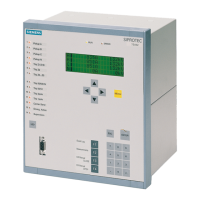1.1 Overall Operation
17
7SD610 Manual
C53000-G1176-C145-4
A voltage measuring input is provided for each phase-earth voltage. In principle, the
differential protection does not require any measured voltage, however, for the direct-
ed overcurrent time protection the connection of the phase earth voltages U
L1
, U
L2
and
U
L3
is definitely required. Additionally voltages that allow to measure voltages and
powers and voltages that enable the user to measure the line voltage also for auto-
matic reclosure can be switched to the device. A further voltage input (U
4
) may option-
ally be used to measure the displacement voltage (e–n–voltage) or for any voltage U
x
(for overcurrent protection). The analog values are transferred further to the IA input
amplifier group.
The input amplifier group IA provides high-resistance termination for the analog input
quantities. It consists of filters that are optimized for measured value processing with
regard to bandwidth and processing speed.
The AD analog digital converter group contains analog/digital converters and memory
components for data transfer to the microcomputer system.
Microcomputer
System
Apart from processing the measured values, the microcomputer system µC also exe-
cutes the actual protection and control functions. They especially consist of:
• Filtering and conditioning of the measured signals
• Continuous monitoring of the measured quantities
• Monitoring of the pickup conditions for the individual protective functions
• Formation of the local differential protection values (phasor analysis and charge
current computation) and creation of the transmission protocol
• Decoding of the received transmission protocol, synchronisation of the differential
protection values and summing up of the differential currents and charge currents
• Monitoring the communication with the device of the remote end
• Querying of limit values and time sequences
• Control of signals for logical functions
• Reaching trip and close command decisions
• Stocking messages, fault data and fault values for fault analysis purposes
• Administration of the operating system and its functions, e.g. data storage, realtime
clock, communication, interfaces, etc.
The information is provided via output amplifier OA.
Binary Inputs and
Outputs
Binary inputs and outputs from and to the computer system are routed via the I/O
modules (inputs and outputs). The “µC” issues information to external equipment via
the output contacts. Outputs are mainly commands that are issued to the switching
devices and messages for remote signalling of events and states.
Front Elements LEDs and an LC display provide information on the function of the device and indicate
events, states and measured values.
Integrated control and numeric keys in conjunction with the LCD facilitate local inter-
action with the local device. All information of the device can be accessed using the
integrated control and numeric keys. This information includes protective and control
settings, operating and fault indications, and measured values; setting parameters can
be changed (see also Chapter 2 and SIPROTEC 4 System Description).
Devices with control functions also allow station control on the front panel.
www . ElectricalPartManuals . com

